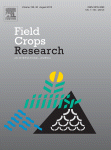Ver ítem
- xmlui.general.dspace_homeCentros Regionales y EEAsCentro Regional Santa FeEEA OliverosArtículos científicosxmlui.ArtifactBrowser.ItemViewer.trail
- Inicio
- Centros Regionales y EEAs
- Centro Regional Santa Fe
- EEA Oliveros
- Artículos científicos
- Ver ítem
Identifying sulfur deficient fields by using sulfur content; N:S ratio and nutrient stoichiometric relationships in soybean seeds
Resumen
Sulfur (S) fertilization has increasingly become an important issue in crop management. In Argentina S deficiencies have been reported, but there has been no success in finding soil tests for predicting soybean response to S fertilization. The objectives of this study were to: (i) evaluate seed S and N:S ratio as a tool for identifying S deficient soybean crops in field conditions and (ii) determine shifts in stoichiometric relationships among nitrogen
[ver mas...]
Sulfur (S) fertilization has increasingly become an important issue in crop management. In Argentina S deficiencies have been reported, but there has been no success in finding soil tests for predicting soybean response to S fertilization. The objectives of this study were to: (i) evaluate seed S and N:S ratio as a tool for identifying S deficient soybean crops in field conditions and (ii) determine shifts in stoichiometric relationships among nitrogen (N), phosphorus (P) and S in soybean seeds which can be used for identifying S responsive sites under field conditions. Seed samples from 20 field experiments designed to explore response to S fertilization in soybean were collected in a large area in the Argentinean Pampas region. Seed yield (SY) and P (%P), S (%S) and N (%N) concentration in seeds were determined. Different data analyses were tested in order to find an S deficiency index. Moderate SY responses to S fertilization were observed in the present study (i.e. relative SY was never below 75%). seed S concentration increased in response to S fertilization in most responsive sites, and N:S ratio was governed by variations in seed S concentration. Stoichiometric relationships were more accurate for identifying S responsive sites than using single variables (e.g. seed S concentration or N:S). The isometric variations among N, P and S suggest that the accumulation of these nutrients is proportional in seed tissue. A significant increase in the intercept of the stoichiometric relationship between N and S in S deficient crops was observed. An S deficient index (SDI) was calculated based on this difference that can be used as a diagnostic tool for identifying S responsive sites in soybean. The present study shows a novel approach for using stoichiometric concepts in fertilizer management in soybean.
[Cerrar]

Autor
Fuente
Field crops research 135 : 107-115. (August 2012)
Fecha
2012-08
ISSN
0378-4290
Formato
pdf
Tipo de documento
artículo
Palabras Claves
Derechos de acceso
Restringido
 Excepto donde se diga explicitamente, este item se publica bajo la siguiente descripción: Creative Commons Attribution-NonCommercial-ShareAlike 2.5 Unported (CC BY-NC-SA 2.5)
Excepto donde se diga explicitamente, este item se publica bajo la siguiente descripción: Creative Commons Attribution-NonCommercial-ShareAlike 2.5 Unported (CC BY-NC-SA 2.5)

